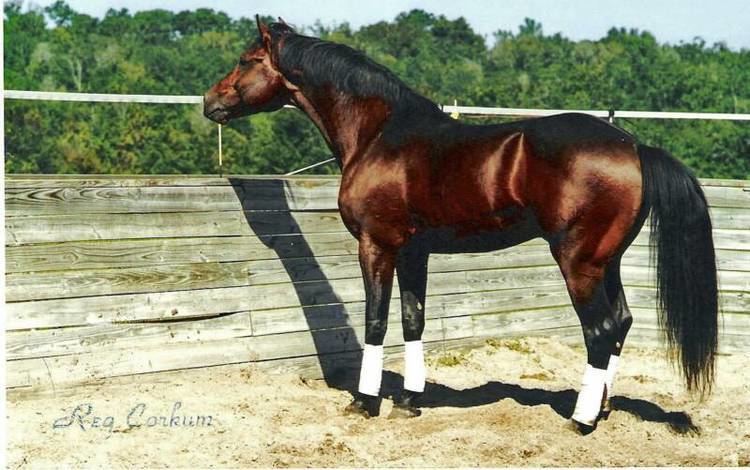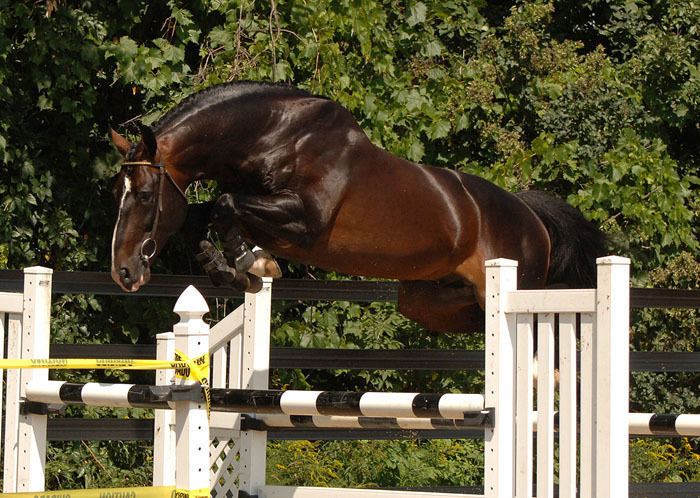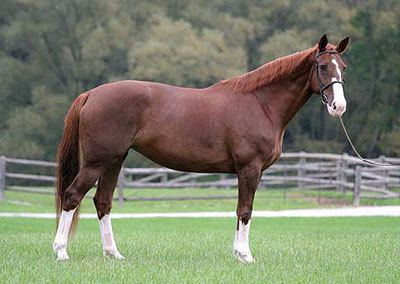Scientific name Equus ferus caballus Country of origin Belgium | Rank Breed | |
 | ||
Other names in error, "Belgium" Warmblood Distinguishing features Modern riding horse type especially suitable for show jumping. Similar Dutch Warmblood, Selle Français, Holsteiner horse, Belgian horse, American Warmblood | ||
A Belgian Warmblood is a warmblood type of horse registered with the Belgisch Warmbloed Paard vzw (Belgian Warmblood Studbook (BWP)) or Studbook sBs. The traits given the greatest importance in the breeding aim of the Belgian Warmblood are performance in show jumping and dressage, as well as subjective conformational correctness and robust health.
Contents
- 8 yr old belgian warmblood gelding
- History
- Breed characteristics
- Uses
- Medical issues
- Belgian sport horse
- References

8 yr old belgian warmblood gelding
History

Horse breeders in the Netherlands, Germany, and France had been producing elegant saddle horses for hundreds of years. However, because the Belgian government was concerned about protecting the bloodlines of the Brabant (Belgian draft horse), it was not until the 1950s that breeders in Belgium were allowed to breed lighter saddle horses.

The foundation stock of the Belgian Warmblood included jumping horses from France and the Netherlands, as well as Hanoverians and Holsteiners from Germany. Through studbook selection, Belgian breeders were able to direct breeding towards their own goals.

The first stallion show for riding horses in Belgium took place, illegally, in 1953; the BWP was founded in 1955. Without native riding horses or all-purpose heavy warmbloods, Belgian breeders had to import stallions and mares. Over the course of 50 years, the BWP accrued a mare base of over 3,500 broodmares and produced a significant number of international-quality show jumpers. In 2010, the BWP was ranked 4th in the FEI/WBFSH International Show Jumping standings, below only the KWPN-Dutch Warmblood, Selle Francais and Holsteiner studbooks.
Breed characteristics

As a warmblood horse, the Belgian Warmblood is characterized not by uniformity of coat color, appearance or pedigree chart, but by uniformity of purpose. Like other warmbloods, Belgian Warmblood breeding horses are subjected to rigorous studbook selection.
The most reliable way to positively identify a Belgian Warmblood is by the brand on the left thigh. Belgian Warmblood foals receive this brand during their foal inspection, when they are given a passport and deemed free of obvious defects.
Between the ages of three and four years old, Belgian Warmblood stallions are presented to a jury in a "Hengstenkeuring" or stallion licensing test. The licensing test consists of a veterinary inspection, subjective evaluation of the stallion's conformation and jumping ability without a rider, and evaluation of the stallion's qualities under saddle. Stallions that do not achieve the desired marks in the licensing test are not eligible for the studbook. To retain status in the studbook, stallions must participate in competitions for young show jumping horses called the "Classic Cycle." Mares take part in similar conformational evaluations, however judgement of a mare's qualities as a riding horse are elective.
The published breeding aim for the Belgian Warmblood reads as follows:
"A noble modern and correctly-built warmblood horse with a rectangular frame, big outlines and good basic paces. The horse should be pleasant to ride and have an unobjectionable character, so that it can be used by any rider, both as pleasure horse and as a performance horse on national and international level. There has to be a balance between conformation, performance and health."
Belgian Warmbloods range in size and substance, but the ideal size for a stallion is between 16 and 17 hands high at the withers. Mares are not eligible for breeding rights unless they exceed 15.1 hands high. In type, the Belgian Warmblood is similar to the Holsteiner, Selle Francais, Dutch Warmblood, and Hanoverian, and less like the Trakehner.
The BWP does not hold any regulations barring horses of certain coat colors; however, the most common coat colors are chestnut ("vos"), bay ("bruin"), brown ("zwartbruin"), black ("zwart"), and grey ("schimmel"). The modifier "donker" means a dark shade, "licht" means light. Modifiers on "schimmel" often indicate the horse's color at birth, for example "bruinschimmel" means a grey born bay. There are also tobiano patterned pinto ("bont") Belgian Warmbloods, though they are uncommon.
Belgian Warmbloods present a unique case in that there is no indigenous warmblood mare base. Of the 181 approved stallions listed, half were themselves Belgian Warmbloods. The remaining half were primarily Holsteiners, Selle Francais, Dutch Warmblood, or Hanoverian; there were a handful of Oldenburg, Thoroughbred, Westphalian, Belgian Sport Horse and Rhinelander stallions as well.
Of the Belgian stallions, about a quarter had a Belgian sire. Another quarter had a Selle Francais sire, while a further 42% had Dutch, Holsteiner, or Hanoverian sires. The remaining sires were Westphalian, Rhinelander, Swedish, Belgian Sport Horse, Oldenburg, or Thoroughbred.
Uses
The slogan of the BWP is "Bred to perform," which accurately describes the aim of the registry. Belgian Warmbloods are best known for their jumping abilities. Olympic show jumpers with the BWP brand include Big Ben (1984), Darco (1992), Egano (1992), Jus De Pomme (1992), Joli Coeur (1996), Sapphire (2008).
Over the past 20 years, research has supported observations regarding the high heritability of jumping ability compared with that of dressage-quality gaits. Therefore, horse breeders may reliably produce exceptional jumpers in few generations, which is exactly what occurred in Belgium. The aim of the BWP has been, from day one, "'always jumping horses'".
The influence of French horses has also given the Belgian Warmblood the ability to be competitive in eventing. Britt was a Belgian Warmblood Olympian in eventing in 1992. In 2006 the studbook as a whole was ranked 15th in eventing by FEI results.
Belgian Warmbloods also appear increasingly in dressage. The FEI and World Breeding Federation for Sport Horses ranked them 11th in 2006. There are strong numbers of Belgian Warmblood show hunters in North America, though their suitability for it depends very much on the individual horse.
Medical issues
The BWP is known for its progressive attitude towards eradicating osteochondritis (OCD) from their population. Stallions undergo radiographing of the feet, fetlocks, knees, hocks, and stifles as a part of the approval process, and are not permitted to breed if they may become unsound. Furthermore, any stallion that later showed signs - through his offspring or otherwise - of carrying a genetic disorder would lose his breeding approval.
As a result, Belgian Warmbloods are not subject to the disorders that affect closed-studbook registries, and progress is being made to make Belgians Warmbloods - as other warmbloods - more sound than ever.
Belgian sport horse
The linguistic and cultural division of Belgium is reflected in the use of two separate warmblood breeding associations. The Belgian Sport Horse differs from the Belgian Warmblood only by location: breeders in northern Belgium typically register with the BWP, while those in the southern part of the country registry with the sBs. Studbook sBs was originally founded in 1920 as Societe d’Encourgement pour L’Elevage du Cheval d’Armes or "Society for the Encouragement of Breeding Army Horses," and produced cavalry horses and remounts for the Belgian army, which at the time were primarily imported from France. Within 10 years, the use of cavalry horses had given way to demand for leisure horses, and the name of the registry was changed to Demi-Sang Belge or "Belgian Half-bred", reflecting the increased use of refined, Thoroughbred-influenced sires. Following World War II, breeders imported substantial numbers of riding horses from France, as well as some from England, Ireland, Germany and the Netherlands. These horses were the foundation of sport horse breeding in the region. Success in breeding warranted another name change in 1967: the "Royal Belgian Sport Horse Society", better known as "Studbook sBs".
